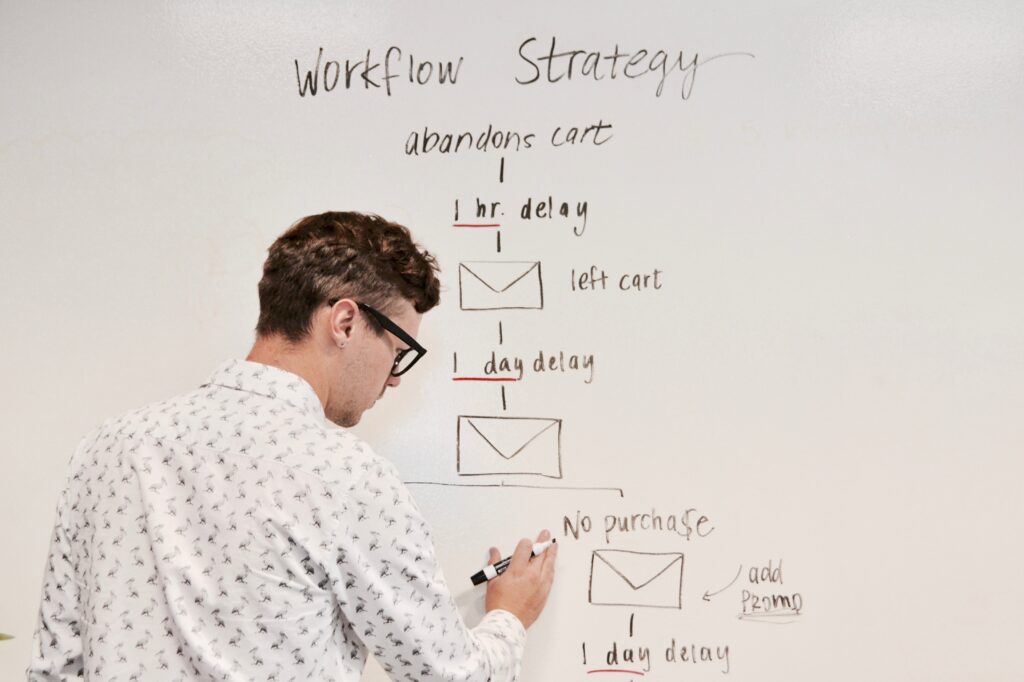It’s possible to irritate your mailing list recipients by bombarding them with messages, but if you send too few emails, it may lead to lost sales opportunities. What is the optimal frequency of emails to encourage engagement?
To reach a conclusion regarding this expensive inquiry, we assessed more than one million campaigns that were sent through GiantCampaign in 2023 to discover how recurrently emails should be dispensed.
We have concluded that the response is… pauses for effect … contingent upon the situation.
We were expecting a simple answer, however, the ideal email frequency is contingent on multiple factors such as your subscribers, the types of emails to be sent, the product or service you are promoting, and the proposal you are making.
We’ve uncovered many exciting revelations through our data analysis. We’ll present them to you along with some helpful advice to decide on the right email frequency.
What is the concept of email cadence?
The frequency and timing of emails sent is referred to as email cadence. The aim of this is to maximize the level of engagement with the emails sent and help reach the goals of email marketing and the overall objectives of the business.
Several elements can affect the ideal frequency of emails for your business in email marketing.
The goods you put up for sale are one such factor. An online shop with a frequently changing product array and often altered offers is likely to send more emails than a shop that concentrates on a limited range of products at a consistent price.
The number of pieces of content you generate will have an effect on the rate of emails sent. If a company produces a large quantity of content, they’ll have more to say than one that doesn’t create much, which could mean they should send emails more frequently.
You can dispatch emails to distinct customer groups with different frequencies. Somebody who recently signed up for a free trial will require frequent emails to understand your product and offer. However, an established customer may only need a periodical newsletter to stay informed on the main updates.
Gaining an understanding of email segmentation is essential to successful email marketing. Knowing what it is and why it is necessary can help optimize your email campaigns. Segmentation is the practice of dividing up your contacts list into smaller groups based on characteristics like demographics and behaviors. By segmenting your contacts, you can tailor your messages to specific audiences, increasing the chances of them engaging with your emails.
What is the aim of determining the ideal frequency for sending emails?
Maximizing the rate of your emails is the best way to ensure that they help you reach your desired objectives.
Optimize your email frequency in order to boost metrics like open rates, click-throughs, and conversions which are associated with email marketing.
If you don’t get it right, the opposite will occur. If you send out too many emails, your subscribers may not recognize their worth and could choose to unsubscribe. If you send out too few, you won’t be able to build a strong connection with your subscribers and therefore miss the chance to make sales.
Examining the pattern of emails sent
No magical formula for the ideal email marketing frequency was uncovered by our data analysis. However, there were some useful insights that can be used to decide how often to deliver emails, for instance:
- What is the frequency of emails sent out by other companies?
- Engagement rates for emails that have been sent at varying frequencies on average
- Establishing a standard for how often emails are sent out by industry
Let’s take a plunge into the data!
This graph displays the percentage of GiantCampaign accounts which transmit campaigns in various mailing frequencies. It should be noted that this data is highlighting campaigns, and not automated emails sent by email marketing workflows .
The following chart shows a comparison of email sending frequency with the number of accounts:

It is evident from this chart that more than half of our customers send multiple emails every month. Additionally, over a third of our customers send emails on a weekly basis. Therefore, it can be deduced that there are many people who send emails more than once a week.
The newest facts demonstrate that the frequency of dispatching has no noteworthy influence on the click-through rate. The CTOR for emails sent two to three times per week was 16.89%, which was only 0.56% below the frequency with the most elevated click-through rate, that being four to five times per week.
No matter how many emails you send out, as long as they provide value, people will be engaging with them according to the data.
The rate of emails sent within particular industries
We studied the rate in which our customers send email marketing messages to their contacts. The chart below provides the median number of days between emails for various industries. Let’s have a look.
Gaining an understanding of the quantity of emails sent by your company should be easier after this, yet it will not be exact. Every business in a specific industry has its own distinct characteristics and provides a variety of services and strategies that will affect the amount of emails dispatched.
The median number of days between emails for the following industries are as follows: Agriculture and food services – 15.06, Arts and artists – 19.03, Author – 18.67, Beauty and personal care – 16.3, Blogger – 12.74, Business and finance – 13.34, Consulting – 12.75, Creative services/agency – 15.17, E-commerce – 13.29, Education and training – 12.6, Educational institution – 12.05, Entertainment and events – 14.86, Health and fitness – 12.64, Hobbies – 11.24, Home and garden – 15.57, Marketing and advertising – 11.42, Media and publishing – 16.02, Medical, dental and healthcare – 16.17, Non-profit – 14.4, Publishing company – 13.15, Real estate – 14.43, Religion – 8.2, Retail – 14.5, Software and web apps – 13.52, and Travel and transportation – 16.2.
The most effective strategies for determining the best frequency to send emails are outlined below.
We will now evaluate 8 tips to enhance email cadence and make use of our data to identify the right frequency. By employing these tactics, we can expect to see increases in opens and clicks, as well as a decrease in unsubscribes.
1. Begin by setting your email marketing ambitions
When deciding on an email cadence, consider what the desired outcome is. Many common objectives include boosting sales, developing relationships with leads, increasing blog visits, establishing a newsletter to build authority, or displaying content to gain revenue from ads.
For each goal, there should be an ideal frequency. To nurture leads, many emails might be needed to maintain a strong presence while they’re interested in making a purchase. However, if you want to create an authoritative newsletter, it is better to only send emails when a high quality article is ready to be shared.
Take into consideration your desired end-goal and then determine how many emails it will require to reach that point.
To find out how to craft email marketing content that your readers will be excited to see, click the link below.
2. Make sure the frequency of emails is adjusted to customer behavior
By using email marketing automation , it is possible to adjust the frequency of emails sent to fit the actions of prospects or clients.
If, for instance, someone opts in to receive a lead magnet, you can provide them with it right away and then send additional details associated with the subject. Additionally, if one of your subscribers registers for a webinar, you can send a follow-up email when the time is right.
Your subscribers will receive pertinent emails at the opportune moments, no matter how often you send out promotional materials.
This article provides illustrations of automation procedures that can be used as a beginning point.
3. Outline expectations in the welcome email message
In order to maintain a contented subscriber base, inform them of the frequency of your email cadence.
It is worthwhile to craft a welcome email that clearly states the frequency of emails you will be sending to subscribers. This will make sure that the recipient is aware of how often they can anticipate communication from you.
At this juncture, you can provide your recipients multiple frequency selections so they can choose a preferred cycle.
4. Segment your subscribers
Providing customers with the option to select the rate of communication is possible by creating targeted segments based on criteria such as interests or locations. This way, you can divide your subscribers into groups and send emails tailored to their interests.
Individuals who demonstrate an enthusiasm for diverse varieties of content will be more likely to receive more emails than those who have particular interests.
Marketing Dive offers a great example of how you can create segment and grouping by providing options on their email signup page. By doing so, they give their subscribers a personalized experience.
A picture from Marketing Dive is depicted below:

Source: Marketing Dive
Incorporate a survey into your newsletter to get feedback from readers.
To determine if your email frequency is effective for your audience, inquire them directly.
Construct a questionnaire via email that inquires if recipients like the present rate of communication or if they would choose to be contacted more or less often.
By taking into account the data, you could contemplate raising or lowering the amount of emails you dispatch.
Here’s an additional hint: Unsubscribe from surveys by using the link below.
Gain insight into why people unsubscribe from your list by utilizing unsubscribe surveys . GiantCampaign offers a pre-set form with five choices, one being The emails are too frequent . If this response continually appears, it’s an indication that you should reduce the number of emails you send.
Seven strategies to build survey invitation emails that get answers (along with examples and templates) can be found in this article. It explains how to get the most out of sending surveys by email.
6. Utilizing A/B testing to discover what subscribers favor
A/B experiments can help to gain a better understanding of how subscribers’ reactions vary depending on the frequency of emails.
It is possible to divide your subscribers into two parts, with one group receiving a weekly newsletter and the other group receiving a bi-weekly newsletter, to evaluate which method yields the highest open and click-through rates.
It is possible to assess elements such as the hour of the email, the day the campaigns are sent out, or the type of material included in them.
After obtaining the outcomes, don’t call it quits! Keep experimenting until you uncover the most effective email cadence for your viewers.
7. Reach out to other divisions
Take caution not to send out too many messages simultaneously from your business. Recipients cannot always tell the difference between a sales email, a product update, and a marketing newsletter. Thus, they will only recognize that they have obtained multiple emails from XYZ company.
Considering this, it is important to ensure that the timing and rate at which you are sending emails is in line with the other departments. This will prevent subscribers from being overwhelmed by too many emails in their inbox.
It would be beneficial to communicate the knowledge from this article to other teams in order to help them maximize their email cadence. Working together across departments to create an email strategy and a schedule can help prevent any conflicts.
8. Analyze the data associated with your emails
One of the easiest ways to get an idea of how your emails are being received is to reference your email analytics. Have a look at the performance reports to find out how your campaigns have been performing.
Your GiantCampaign dashboard provides a way to track important figures such as open rates, click-through rates, and unsubscribe count. You can modify your email cadence and observe the results it has on your metrics. Use the feedback that you get to perfect your sending frequency.
Crafting a good email marketing campaign requires more than a regular cadence of emails
There is no single type of emailing schedule that works for everyone, however, it is possible to discover a method that is most suitable and utilize it.
It is virtually impossible to pinpoint one specific factor like the frequency of emails sent or the subject line as the sole cause of success in email marketing. To get higher open rates and more clicks, all the elements of emails must work together to meet the expectations of subscribers.
Frequency of communication should depend on the subscriber’s needs; if they require regular updates, then emails should be sent out on a weekly basis. If they need to hear from you less often, then it is necessary to conduct some tests to determine the most suitable interval between emails.
Generate strategies that people enjoy
This is your opportunity to utilize the email cadence techniques you just learned. Get started by registering with GiantCampaign and utilize the guidelines from this article to craft campaigns.
Begin your journey at no cost by signing up at GiantCampaign !
The use of technology in education has become commonplace in recent years; it has become an integral part of the teaching and learning process. Nowadays, computers and other digital technology are frequently employed in classrooms, allowing students to access a wide range of educational resources and gain skills which are essential for the 21st century. This has resulted in an increased level of engagement for students, enabling them to learn in more interactive and engaging ways.






